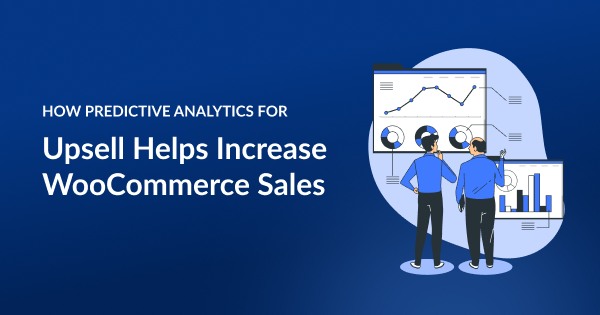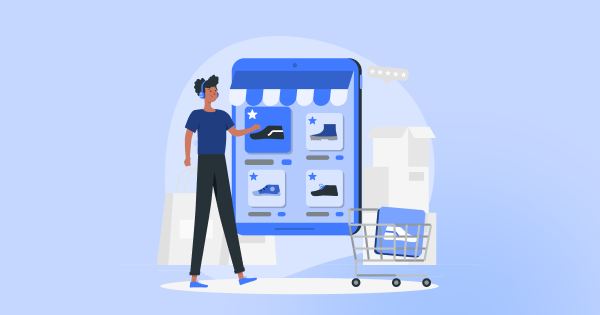Post BFCM Sale: Save upto 60%!
Offer valid for a short period.
00
Days
00
Hours
00
Minutes
00
Seconds
Post BFCM Sale: Save upto 60%!
Offer valid for a short period.
Increase Your Order Value With Smart Upsells
Personalize product recommendations, customize upsell offers, increase AOV, and boost sales with our all-in-one WooCommerce Upsell plugin.


If you are a WooCommerce store owner wanting to increase revenue, then increasing sales along with providing a personalized shopping experience is essential. One of the most effective strategies to achieve this is through predictive analytics for upsell.
Predictive analytics for upsell involves leveraging data, machine learning, and intelligent algorithms with which businesses can boost revenue while offering a more tailored experience to customers. In this article, we will dive deep into how predictive analytics for upselling can significantly increase WooCommerce sales.
Improve conversion rates in your WooCommerce store by offering complementary products at checkout using the UpsellWP plugin.
Before delving into its benefits, let’s first define predictive analytics for upsell. Predictive analytics uses data, statistical algorithms, and machine learning techniques to analyze historical data and make predictions about future outcomes.
In the context of WooCommerce, predictive upselling refers to using this data to forecast which products a customer is likely to purchase next, thereby offering relevant and personalized upsell suggestions.
Using predictive analytics for upsell, WooCommerce stores can anticipate customer needs and suggest complementary products at the right moment in their shopping journey. This form of sales forecasting can be used to increase the average order value (AOV) and drive higher conversion rates, creating a win-win situation for both the business and the customer.
Incorporating predictive upselling in WooCommerce can drastically enhance the customer experience. Personalized upsell offers increase the chances of a successful sale. By recommending products that align with the customer’s interests, businesses can not only boost revenue but also foster loyalty and improve customer satisfaction.
Moreover, predictive upsell strategies for WooCommerce help businesses stay ahead of the competition. They enable store owners to provide a smarter, more efficient shopping experience, which is something customers increasingly expect. In essence, predictive analytics for upsell serves as a critical tool for driving long-term growth.
The role of predictive analytics for upsell in enhancing WooCommerce sales is undeniable. By utilizing data-driven insights, WooCommerce businesses can optimize their upsell strategies to meet customer demands effectively. Here’s how predictive analytics works to drive sales:
One of the most significant benefits of predictive upselling for WooCommerce is its ability to increase the average order value (AOV). Predictive models analyze past customer behavior and transaction history to suggest products that are most likely to be purchased together.
By presenting these upsell opportunities during the checkout (WooCommerce Checkout Upsells) or browsing stages, WooCommerce stores can encourage customers to add more items to their carts, leading to higher AOV.
With predictive upsell techniques for WooCommerce, businesses can create highly relevant and timely product suggestions, leading to improved conversion rates. Customers are more likely to purchase products that match their needs and preferences, making it easier to upsell them on complementary items.
By predicting these needs, WooCommerce stores can enhance the customer journey, increasing the chances of successful sales.

Predictive analytics for WooCommerce upselling leverages customer data to create highly personalized offers. By analyzing previous browsing history, purchasing patterns, and preferences, businesses can recommend items that resonate with individual customers.
This level of personalization is critical in today’s competitive WooCommerce landscape, where generic product recommendations often fall short of meeting customer expectations.
Also Read: UpsellWP’s Smart Product Recommendations helps suggest products to your customers based on their purchase history.
With the help of predictive upsell models, WooCommerce stores can develop data-driven marketing strategies that are more likely to convert. These strategies allow businesses to target specific customer segments based on their preferences and behavior.
For example, customers who have purchased a particular product may be more inclined to buy complementary items such as accessories or related products. Predictive analytics helps identify such opportunities, allowing businesses to create more targeted marketing campaigns.
Implementing predictive upsell strategies in WooCommerce involves several key steps to ensure your upsell campaigns are effective, personalized, and data-driven. Below, each step is broken down clearly to help you understand how to leverage predictive analytics for better upselling results.
a) Choose a Tool or Plugin: Begin by selecting a tool that integrates predictive analytics for upselling into your WooCommerce store. For example, UpsellWP is an excellent option as it allows you to display personalized upsell recommendations at various touchpoints like the product page, checkout, and post-purchase pages.
Other tools like WooCommerce Analytics and third-party plugins can also help gather and analyze customer data.
Also Read: Easily add WooCommerce Product Page Upsell using the UpsellWP plugin in WooCommerce.
b) Installation: Install and configure the plugin or tool on your WooCommerce store. Most plugins, including UpsellWP, have user-friendly installation wizards to guide you through the process. You might need to set up the plugin to work with your product catalog and customer data.
a) Gather Data from Customers: Predictive analytics works by analyzing historical customer data. Collect data on customer behavior, past purchases, browsing history, and preferences. With UpsellWP, the plugin helps gather and analyze this data to predict which products a customer is most likely to buy next.
b) Segmentation: Segment your customers based on different factors such as demographics, buying history, and browsing behavior. This helps create targeted upsell campaigns. For instance, repeat customers may have different upsell suggestions compared to first-time visitors.

a) Product Recommendations: Based on the data collected, predictive upsell strategies suggest products that are highly relevant to individual customers. For example, if a customer frequently buys tech gadgets, the upsell offer can be for accessories related to those products, such as chargers or cases. Tools like UpsellWP use algorithms to determine which products are best suited for upselling.
b) Customizing Offers: Customize your upsell offers to suit customer needs. You can offer discounts, special bundles, or limited-time deals based on predictive models that are tailored to customer behavior.
a) Strategic Timing: The timing of your upsell offers is critical. With predictive upsell techniques, you can offer suggestions when they are most likely to be accepted. For example, suggesting a related product during checkout or after the customer has completed a purchase can increase the chances of success.
b) Contextual Upselling: Make sure the upsell offer aligns with what the customer is already purchasing or considering. UpsellWP offers contextual recommendations, which means the upsell suggestions are tailored specifically for the products already in the customer’s cart.
a) Track Metrics: Once the upsell strategy is in place, track important metrics such as upsell conversion rates, average order value (AOV), and click-through rates (CTR). This will help you gauge the success of your predictive upsell campaign.
b) Continuous Refinement: As you gather more data, refine your upsell strategies. Predictive analytics tools can be recalibrated to improve recommendations over time. With UpsellWP, you can easily tweak the upsell conditions and optimize the product suggestions for better performance.
When it comes to implementing predictive upsell strategies, choosing the right tools is essential. Several powerful tools can help WooCommerce store owners leverage predictive analytics to maximize their upsell potential. Here are some of the top tools available:

UpsellWP is a powerful WooCommerce plugin designed to help store owners maximize sales by suggesting relevant upsell and cross-sell products. The plugin uses predictive analytics to recommend the most likely products a customer will purchase based on their browsing and purchase behavior.
This plugin integrates seamlessly with your store and offers customizable upsell pop-ups, banners, and on-page recommendations. With UpsellWP, you can craft highly personalized upsell offers that increase average order value (AOV) and conversion rates.
Boost customer loyalty by offering next order coupons to your customers upon purchase using the UpsellWP plugin.
WooCommerce Predictive Analytics is a tool that integrates directly into your WooCommerce store to forecast customer behavior. It analyzes historical data to predict which products are most likely to be purchased together and provides upsell opportunities accordingly.
This tool uses sophisticated machine learning algorithms to improve recommendations over time, making it a smart choice for stores aiming for long-term success.
Recom.ai is another excellent tool for predictive upselling. It uses machine learning to recommend products based on customer data, which includes past purchases and browsing history. Recom.ai also helps with product bundles and offers smart product recommendations that increase sales and improve customer experience.

Klaviyo is a robust email marketing platform that also supports predictive analytics for upselling. It integrates with WooCommerce to offer personalized email campaigns and automated product recommendations based on customer data.
By predicting which products customers are likely to purchase, Klaviyo helps WooCommerce store owners enhance their upsell strategies and create highly targeted, relevant marketing campaigns.

Dynamic Yield is a comprehensive personalization platform that integrates with WooCommerce to provide predictive product recommendations. It offers AI-powered tools to suggest relevant upsell products based on customer data.
Dynamic Yield’s machine learning algorithms continuously learn from customer behavior, helping to personalize the shopping experience and increase sales.
To truly leverage predictive analytics for WooCommerce upselling, it’s essential to follow best practices that will ensure your upsell campaigns are successful. Here are some key tips to maximize your upsell success:
To gauge the effectiveness of your predictive upsell campaigns, it is crucial to track and measure key performance indicators (KPIs). Below are several important metrics that can help you understand how well your campaigns are performing.
The most direct metric for measuring the success of your upsell campaigns is the conversion rate. This refers to the percentage of customers who click on or accept your upsell offers. A higher conversion rate indicates that your predictive analytics are accurately recommending products that resonate with your customers.
Average Order Value (AOV) is a critical metric for any upsell campaign. It measures the average value of a customer’s order. If your predictive upsell strategies are successful, you should see an increase in AOV, as customers are purchasing more products due to your upsell suggestions.
WooCommerce Customer retention is a long-term measure of success. Predictive analytics for upsell can help you personalize offers and improve the customer experience, leading to higher retention rates. Satisfied customers who receive relevant product suggestions are more likely to return and make repeat purchases.
Click-through rate (CTR) is another key metric to track. This refers to the percentage of customers who click on your upsell offers. High CTR means your upsell recommendations are engaging and relevant to your audience, indicating effective use of predictive analytics.

To determine whether your predictive upsell campaigns are generating sufficient returns, calculate the ROI. This measures the revenue generated from upsell offers against the cost of implementing and running the campaigns. A positive ROI means your strategy is profitable and worth continuing.
Customer Lifetime Value (CLV) measures the total revenue a customer is likely to generate during their relationship with your store. By offering targeted upsell products through predictive analytics, you can increase the CLV by encouraging customers to make larger purchases and return more frequently.
Bounce rate measures how many users leave your page without interacting. If you notice a high bounce rate on your upsell pages, it may indicate that the upsell offers are irrelevant or poorly timed. Predictive upsell strategies can help reduce bounce rates by ensuring the recommendations are personalized and compelling.
Let’s look at a few real-world examples where predictive analytics for upsell has been successfully implemented to increase sales and improve customer experience.
Case Study 1: A Fashion Retailer Increases AOV by 25%
A WooCommerce-based fashion retailer decided to implement predictive upselling using a plugin like UpsellWP. By analyzing customer behavior and purchase history, the retailer was able to recommend complementary products like accessories, shoes, and handbags to customers already shopping for clothing.
The result? A 25% increase in average order value (AOV). Customers were more likely to purchase accessories with their clothing, and the retailer saw a significant boost in overall sales and revenue.
Case Study 2: Electronics Store Sees 30% Increase in Sales
An electronics store leveraging predictive analytics for upselling saw a 30% increase in sales by suggesting tech accessories alongside their core products. Customers purchasing phones were shown upsell offers for cases, chargers, and headphones, which increased their likelihood of adding these items to their carts.
By using UpsellWP to deliver these recommendations at the right moments, the store achieved higher upsell conversion rates and improved overall sales performance.
Case Study 3: Beauty Brand Improves Customer Retention
A beauty brand used predictive upselling to recommend skincare products based on customers’ previous purchases. This personalized approach increased customer retention rates and sales as customers found value in the targeted recommendations.
The brand’s CLV improved significantly, demonstrating that predictive upsell strategies were not only boosting immediate sales but also fostering long-term customer relationships.
Increase the average order value of your store by allowing customers to add related products with just a single click and make the process convenient for them using the UpsellWP plugin.
In conclusion, predictive analytics for upsell is a powerful tool that can help WooCommerce stores increase sales, improve conversion rates, and enhance the customer experience.
By implementing predictive upsell strategies that are personalized, data-driven, and timely, businesses can unlock new revenue streams and create long-term customer loyalty.
As more WooCommerce stores adopt predictive upselling techniques, it’s clear that this strategy will play an essential role in the future of e-commerce growth.
Related Read:
Predictive analytics for WooCommerce cross-sell uses customer data to predict additional products they may purchase. It helps businesses offer personalized suggestions based on buying behavior. Tools like Predictive AI Software are commonly used for this, enhancing the customer experience and driving sales.
Examples of predictive analytics include Predictive Analytics for Upsell Examples like recommending products based on customer behavior. Predictive Analytics for Customer Churn helps identify at-risk customers. Predictive AI Companies provide software that enables businesses to forecast trends and optimize strategies.